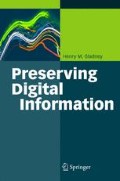Abstract
We want unambiguous communication with future generations with whom dialog is impossible, without restricting what today’s authors can communicate. For this, we need language that we can confidently expect our descendants to understand easily. This challenge is the kind of language problem that has been central to computer science since it emerged as a discipline in the 1960s. Its core can be restated as, “ensure that an arbitrary computer program will execute correctly on a machine whose architecture is unknown when the program is saved.”
Access this chapter
Tax calculation will be finalised at checkout
Purchases are for personal use only
Preview
Unable to display preview. Download preview PDF.
References
A concise account of Turing’s invention of universal computers can be found in Davis 2000, Engines of Logic, Ch. 7. Virtual machines have many uses. See Rosenblum 2005, The Reincarnation of Virtual Machines.
This chapter adapts Gladney and Lorie 2005.
Ross 1999. Digital Archaeology: Rescuing Neglected and Damaged Data Resources, http://www.ukoln.ac.uk/services/elib/papers/supporting/pdf/p2.pdf.
Bjørner 1982, Formal Specification and Software Development.
Gordon 1979, The Denotational Description of Programming Languages.
Mellor 2002, Migration on Request. Oltmans 2005, A Comparison Between Migration and Emulation in Terms of Costs.
Lawrence 2000, Risk Management of Digital Information: A File Format Investigation, http://www.clir.org/pubs/reports/pub93/contents.html.
For rescuing data that have been neglected for years, transformative migration can be an option. See Green 1999, Preserving the Whole: A Two-Track Approach to Rescuing Social Science Data and Metadata, http://www.clir.org/pubs/abstract/pub83abst.html.
Rothenberg 1995, Ensuring the Longevity of Digital Documents.
Donoughue 2002, The Mystery of the Hieroglyphs.
The specifications for XML 1.0, for XML Namespaces, for XPath, and for XPointer are the core needed by information consumers’ agents. See IBM 2004, A Survey of XML Standards, http://www-128.ibm.com/developerworks/xml/library/x-stand1.html.
C. Huc et al., How to Evaluate the Ability of a File Format to Ensure Long-Term Preservation for Digital Information, http://www.nesc.ac.uk/action/esi/download.cfm?index=2823
Wilson 2002, Access Across Time: How the NAA Preserves Digital Records, at http://www.erpanet.org/events/2003/rome/presentations/Wilson.ppt.
Library of Congress news release, http://www.loc.gov/today/pr/2006/06-097.html.
U.K. Arts and Humanities Data Service [AHDS], Moving Images and Sound Archiving Study, http://www.jisc.ac.uk/index.cfm?name=project_movingimagesound.
JFIF JPEG File Interchange Format, http://www.digitalpreservation.gov/formats/fdd/fdd000018.shtml.
XHTML Extensible HyperText Markup Language, http://www.w3.org/TR/xhtml1/.
The Java Virtual Machine Specification, http://java.sun.com/docs/books/vmspec/.
Ford 2006, VXA: A Virtual Architecture for Durable Compressed Archives, http://arxiv.org/abs/cs/0603073.
Hunter 2004, PANIC—An Integrated Approach to the Preservation of Complex Digital Objects using Semantic Web Services, http://www.iwaw.net/05/papers/iwaw05-hunter.pdf.
Lorie 2002. The UVC: A Method for Preserving Digital Documents: Proof of Concept, http://www.kb.nl/hrd/dd/dd_onderzoek/reports/4-uvc.pdf.
IBM, Digital Asset Preservation Tool, http://www.alphaworks.ibm.com/tech/uvc/download.
NAA 2006, Digital Preservation: Illuminating the Past, Guiding the Future, http://www.naa.gov.au/recordkeeping/preservation/digital/XENA_brochure.pdf.
Rights and permissions
Copyright information
© 2007 Springer-Verlag Berlin Heidelberg
About this chapter
Cite this chapter
(2007). Durable Representation. In: Preserving Digital Information. Springer, Berlin, Heidelberg. https://doi.org/10.1007/978-3-540-37887-7_12
Download citation
DOI: https://doi.org/10.1007/978-3-540-37887-7_12
Publisher Name: Springer, Berlin, Heidelberg
Print ISBN: 978-3-540-37886-0
Online ISBN: 978-3-540-37887-7
eBook Packages: Computer ScienceComputer Science (R0)

